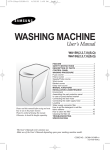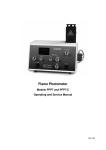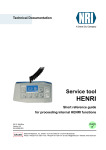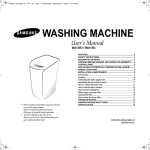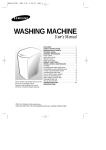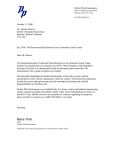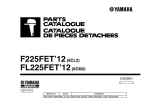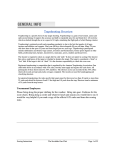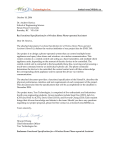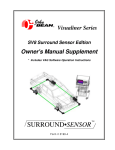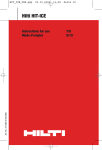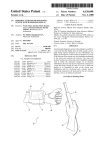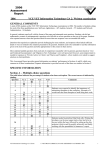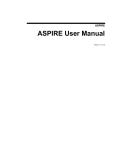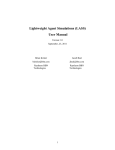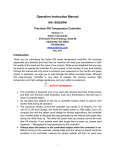Download RamanFlex School of Engineering Science Burnaby, BC V5A 1S6
Transcript
RamanFlex School of Engineering Science Burnaby, BC V5A 1S6 October 17, 2002 Dr. Andrew Rawicz School of Engineering Science Simon Fraser University Burnaby, British Columbia V5A 1S6 Dear Dr. Rawicz, Enclosed are the functional specifications for a Gas Analyzer based on measurements of the Raman effect. This document details both our goals for the remainder of this semester, and some product requirements which we do not anticipate meeting, but which would be important for a productionquality product. These specifications also contain a high-level description of the Raman effect, with the intent to convince you that it is possible for us to construct such a device. I must stress, again, that we are planning the completion of a lab-bench prototype. We intend to spend our time exploring the process of measuring the Raman spectrum of a gas. We do not expect to have time to perfect or even investigate large portions of the surrounding infrastructure that a gas analyzer requires: for example, we expect to measure the Raman spectrum of laboratory air, rather than a sample gas from another source. There are still a large number of requirements which a commercial product would have to meet; these requirements are also explored in this document. To neglect them now would result in a product which meets a small portion of requirements, but perhaps precludes others required for the device’s commercial viability due to oversight. Therefore, we have tried to be both comprehensive and realistic in our analysis. If there are any questions, concerns, or comments, do not hestitate to contact any member of the design team. Our contact information has been included in the first page of our proposal. Sincerely, Graeme Smecher Project Lead RamanFlex RamanFlex Functional Specification October 17, 2002 The Fine Print This document reflects the plan for a four-month project, and is accurate to the best of our abilities. The project is, however, a moving target. Therefore, this document is subject to revision. The RamanFlex team may be contacted en masse at [email protected]. Alternately, our individual contact information is as follows: name e-mail home Simon Laalo [email protected] 604-942-9935 Jon Jolivet [email protected] 604-444-3431 Graeme Smecher [email protected] 604-324-5055 Bernard Smit [email protected] 604-945-7155 cel / pager 604-473-1367 604-837-9468 This is Version 1 of this document, prepared on October 17, 2002. Please check for newer versions with one of the above contacts. 1 RamanFlex Functional Specification October 17, 2002 Abstract This functional specification details the investigation and prototyping of a gas analyzer based on the Raman effect. Because it is a functional specification, it focuses on the boundaries and interfaces between such a device, its operator, and its environment. Because of the long exploratory phase involved with developing a project as technically involved as this gas analyzer, the RamanFlex team has divided our functional goals and constraints into several categories. We are careful to distinguish between the limited set of goals which we intend to complete during the Fall 2002 semester, and either the required or “wish-list” goals to which a production-quality device would be subject. Even though we cannot hope to achieve many of the second set of goals within the time constraints facing us, we intend to remain careful not to reduce our commercial viability by precluding a particular function or goal by accident. For this reason, we have attempted to provide a complete analysis, which reaches beyond our short-term goals for the remainder of this semester. We will construct the gas analyzer in two phases. The initial phase concludes with the completion of a proof-of-concept. This laboratory prototype will: 1. Produce a Raman Spectrum of the air in the lab. 2. Detect the Raman signatures for O2 and N2 in the above spectrum through manual calibration. 3. Produce a digital output value for each of the above signatures which is proportional to the intensity of each wavelength. 4. Provide a system of equations which can be used with the above digital values to provide the percent composition of the gases O2 and N2 in the laboratory air. Once the above requirements have been met, the second phase of development can begin. In the second phase, we will design a production-grade prototype model which will meet several additional requirements. The production prototype will: 1. Produce a Raman Spectrum of a gas mixture contained in a closed sampling chamber. 2. Detect the Raman signatures for a wide array of gases, including O2 , N2 , CO2 , CO, NO, and others. 3. Produce a digital output value for each of the above signatures which is proportional to the intensity of each wavelength. 2 RamanFlex Functional Specification October 17, 2002 4. Calculate the percent composition of each of the gases in the sample, within the accuracy level required for commercial dive shop use. 5. Provide a pass/fail grade for a particular sample, compared against a standard air rating such as CSA Grade E. 6. Be self contained, reliable, easily used, and meet all necessary CSA and PADI standards for commercial dive shop use. 7. Be manufactured for a cost in line with the market sale price for such a device in a commercial (non-laboratory) environment. 8. Be inexpensive to operate continuously, both in terms of electrical consumption and maintenance schedule. We will finish the first of the above phases in December 2002. 3 RamanFlex Functional Specification October 17, 2002 Contents 1 Introduction 1.1 References . . . . . . . . . . . . . . . . . . . . . . . . . . . . . . . . . . . . . 1.2 Intended Audience . . . . . . . . . . . . . . . . . . . . . . . . . . . . . . . . 6 7 7 2 Project Overview 7 3 Technical Foundations 3.1 The Raman Effect . . . . . . . . 3.2 The Strength of the Raman Effect 3.3 Detecting the Raman Effect . . . 3.4 Digitizing the Raman data . . . . 3.5 Feasibility Conclusions . . . . . . . . . . . 8 9 9 10 11 12 4 Requirements and Limitations 4.1 Scope . . . . . . . . . . . . . . . . . . . . . . . . . . . . . . . . . . . . . . . 4.2 Acronyms and Definitions . . . . . . . . . . . . . . . . . . . . . . . . . . . . 4.3 Conventions . . . . . . . . . . . . . . . . . . . . . . . . . . . . . . . . . . . . 12 12 13 13 5 System Requirements 5.1 Physical Requirements . . . . . . . . . . . 5.1.1 General . . . . . . . . . . . . . . . 5.1.2 Robustness . . . . . . . . . . . . . 5.1.3 Required Connections . . . . . . . 5.2 System Performance Requirements . . . . 5.2.1 Analysis Specifications . . . . . . . 5.2.2 Operational Specifications . . . . . 5.3 Reliability and Servicability . . . . . . . . 5.3.1 Required Maintenance . . . . . . . 5.3.2 Operational Lifetime . . . . . . . . 5.3.3 Repairability . . . . . . . . . . . . 5.4 User Interface Requirements . . . . . . . . 5.4.1 PC GUI requirements . . . . . . . 5.4.2 On System Indicators and Controls 5.5 Safety & Regulatory Requirements . . . . 5.5.1 CGA . . . . . . . . . . . . . . . . . 5.5.2 CSA/UL . . . . . . . . . . . . . . . 5.5.3 User Warnings . . . . . . . . . . . 5.6 Safety Features . . . . . . . . . . . . . . . 14 14 14 14 15 15 15 16 17 17 17 17 17 18 18 18 18 18 19 19 . . . . . . . . . . 4 . . . . . . . . . . . . . . . . . . . . . . . . . . . . . . . . . . . . . . . . . . . . . . . . . . . . . . . . . . . . . . . . . . . . . . . . . . . . . . . . . . . . . . . . . . . . . . . . . . . . . . . . . . . . . . . . . . . . . . . . . . . . . . . . . . . . . . . . . . . . . . . . . . . . . . . . . . . . . . . . . . . . . . . . . . . . . . . . . . . . . . . . . . . . . . . . . . . . . . . . . . . . . . . . . . . . . . . . . . . . . . . . . . . . . . . . . . . . . . . . . . . . . . . . . . . . . . . . . . . . . . . . . . . . . . . . . . . . . . . . . . . . . . . . . . . . . . . . . . . . . . . . . . . . . . . . . . . . . . . . . . . . . . . . . . . . . . . . . . . . . . . . . . . . . . . . . . . . . . . . . . . . . . . . . . . . . . . . . . . . . . . . . . . . . . . . . . . . . . . . . . . . . . . . . . . . . . . . . . . . . . . . . . . . . . . . . . . . . . . . . . . . . . . . . . . . . . . . . . . . . . . . . . RamanFlex Functional Specification 5.7 5.8 October 17, 2002 Market and Manufacturing Requirements . . . . . . . . . . . . . . . . . . . . Documentation and Training Materials . . . . . . . . . . . . . . . . . . . . . 6 Test Plan 6.1 Deriving Raman wavelengths . 6.2 Calibrating the Device . . . . 6.3 Taking a Sample . . . . . . . 6.4 Evaluating a Sample . . . . . . . . . . . . . . . . . . . . . . . . . . . . . . . . . . . . . . . . . . . . . . . . . . . . . . . . . . . . . . . . . . . . . . . . . . . . . . . . . . . . . . . . . . . . . . . . . . . . . . . . . . . . . 7 Conclusion 19 19 19 20 20 21 21 21 List of Figures 1 A general block diagram . . . . . . . . . . . . . . . . . . . . . . . . . . . . . 10 List of Tables 1 Raman shifts for gases of interest . . . . . . . . . . . . . . . . . . . . . . . . 5 20 RamanFlex Functional Specification 1 October 17, 2002 Introduction The purpose of a functional specification is to outline the boundaries between a device, its user, and its environment. It may be viewed, in essence, as a contract which such a device must meet in order to achieve its designers’ goals. This contract entails far more than the user interface itself. All constraints that apply to a product — power consumption, operating conditions, safety requirements, and so forth — are fodder for this functional specification. Because there is so much ground to cover, we have tried to maintain a consistent level of detail. Some considerations will be omitted because they would require a level of detail which belongs in the design specifications; they may, after such a document is completed, be introduced to successive revisions of this document. The device outlined in these specifications, though it has applications ranging beyond SCUBA diving, is primarily intended to afford divers and compressor operators some immediate feedback on the quality of their air mixtures. The device is designed to provide an in-situ analysis of breathing gas for compressor operators at the time of tank filling. Additionally, the contents of a previously filled cylinder could be verified. The device specified will provide concentration information for a wide variety of gases, including nitrogen and helium, which are currently inaccessible using existing technology outside of a laboratory environment. We will provide continuous, rapid feedback on gas contents. The development of our laboratory prototype should proceed with the goal of producing a commercial product costing between $1,000 and $3,000. The device prototype will be developed in several phases; the initial phase (completion targeted for Dec 2002) consists of a lab bench prototype device to provide a proof of concept for the technology and components to be used. We intend to demonstrate that a commercial gas analyzer based on the Raman effect is both possible and economically viable for breathing gas analysis. The remainder of this document is laid out in several sections. We will provide: • a brief explanation of the need which we are attempting to address, • an introduction to the Raman effect, and an exploration of the feasibility of measuring it, and • a list of constraints and requirements for the project to be considered a success. 6 RamanFlex Functional Specification 1.1 October 17, 2002 References Two ICs are referenced in a feasability study included below. • The datasheet for the Atmel TH7834C may be found at http://www.atmel.com/ atmel/acrobat/doc1997.pdf. • The datasheet for the National Semiconductor LM9823 may be found at http://www. national.com/ds/LM/LM9823.pdf. In addition, the following printed materials are referenced: Schrötter, H. W. 1982. “Linear Raman Spectroscopy: A State of the Art Report”. NonLinear Raman Spectroscopy and Its Chemical Applications, p. 19 1.2 Intended Audience This document is intended as a design guideline for engineers to track the design requirements and any requirement changes. The project and company management will use this document to ensure that the proposed design meets all of the requirements, and that any changes to the requirements are properly tracked and mutually agreed upon by both the design team and management prior to impacting the design specifications. Marketing and Sales will use this document to plan sales strategies, and to contribute to the design process via requirements change requests when applicable. 2 Project Overview Without an understanding of the market space we are attempting to meet with this project, as well as the technical foundations of our solution, it is difficult to motivate the requirements we intend to meet. The following material attempts to briefly explain our reasons for embarking on this project. Afterwards, we provide an explanation of the technical foundations of this project. SCUBA divers breathe compressed gas. Because of the expense and expertise required to safely operate a compressor, very few divers fill their own tanks. Instead, they buy air from dive shops, charter operators, and sometimes even gas stations. 7 RamanFlex Functional Specification October 17, 2002 The operators of these shops are generally knowledgeable and trustworthy. However, sometimes, the compressor’s operating or maintainence schedules, or a lack of expertise of the staff, lead to unsafe situations. It is extremely easy for a poorly maintained or installed compressor to introduce toxins to the air it produces. Additionally, an increasingly large number of technical divers use “mixed gas.” Mixed gas is created when divers change the concentrations of the major components in air, or introduce other gases such as Helium. Divers use mixed gases because it is absorbed differently by their bodies, which allows them to dive in more demanding situations. Often, mixed gases allow longer or deeper dives than would be possible using regular air. The problem with mixing gas is simple: divers need to know the concentration of each gas in their mixture in order to dive safely with it. There are commercially available devices to measure the concentration of several of these gases, but they cannot measure at least two of the constituent gases of clean air. We are attempting to prototype a gas analyzer that will determine some of the constituents of a breathing gas sample. We do not anticipate having the accuracy to determine all of the constituents. Before explaining our goals for the semester, an explanation of the physical basis of our analyzer helps to provide an understanding of the strengths and limitations which we expect to encounter. 3 Technical Foundations There are a number of situations in which we expect our gas analyzer will excel and a number of situations in which we expect to encounter limitations. All of these situations directly result from the physics behind the Raman effect, which will allow our analyzer to measure sample concentrations. Because many of our functional requirements and restrictions are intimately tied to these results, we present a brief description of the Raman effect. Also, since the Raman effect is extremely difficult to measure, we provide a high-level calculation in an attempt to demonstrate that measuring the Raman effect is within our grasp. Unfortunately, the feasibility study requires some order-of-magnitude figures that require us to draw design details (such as some IC characteristics) into this document. Due to the roughness of the following calculations, however, we expect that part substitutions will not greatly effect the results of the following sections. 8 RamanFlex Functional Specification 3.1 October 17, 2002 The Raman Effect When a light beam passes through a gaseous sample, the photons that make up the light beam pass the particles that make up the sample. Sometimes, photons and molecules interact, resulting in a measureable change in the properties of the light beam. Most of the time, these interactions simply changes the direction of the light beam. This effect is not unlike a flashlight beam passing through fog; the light scatters in many different directions. However, a very small proportion of photon-particle interactions cause the photon to be absorbed and re-emitted by the particle. In these interactions, the energy of the photon (manifested in its colour) changes in a way that is unique for the gas particle. The result is that, by shining a very intense beam containing only a single colour of light, we can detect a “fingerprint” that contains enough information to determine what’s in the sample gas. Lasers provide a suitably high-intensity, monochromatic beam. Almost all materials have a Raman spectrum. However, monoatomic gases such as Helium do not. Since Helium is used in mixed-gas diving, measurement of its concentration is important for a commercial device. However, by including a pressure sensor, the combination of pressure data and the concentrations of the other gases can be used to derive Helium concentration. Such a pressure sensor can also be used to provide an overpressure warning and calibration data. Figure 1 shows the basic configuration of our device. 3.2 The Strength of the Raman Effect The reason that we don’t see the Raman effect in everyday circumstances is that is is extremely faint. (A related, but slightly stronger process known as Raleigh scattering is what provides the sky with its blue tint.) Scattering theory indicates that we can expect the Raman scattering to have an intensity of about 10−7 times the intensity of the laser beam. We are anticipating a laser intensity of on the order of 300mW = 0.300J/s; therefore, the Raman fingerprint signal will have a strength of about 3 × 10−8 J/s. 9 RamanFlex Functional Specification October 17, 2002 Laser Module Laser beam Sample Chamber Controller Module Digitized signal Raman scattered light Sensor RS-232 to PC Figure 1: A general block diagram 3.3 Detecting the Raman Effect CCD sensors, such as the camera elements used in digital cameras, have the ability to collect energy from a sensor for long periods of time. CCDs behave as charge integrators: that is, they can detect an extremely faint signal, if they are allowed to collect it for a long period of time. The sensitivity of CCD sensors is typically measured in V /µJ/cm2 . A nominal value for one device (the Atmel TH7834C) is about 5V /µJ/cm2 . To simplify calculations, we must make several assumptions. First, assume that the above signal strength (3 × 10−8 J/s) is the strength of a single Raman fingerprint. These fingerprints are measured on the CCD as pixels; let us assume that the entire Raman signal for a single fingerprint falls on a single sensor element, or pixel. 10 RamanFlex Functional Specification October 17, 2002 Therefore, for the Atmel TH7834C (which has pixel sizes of 6.5 × 6.5µm = 4.225 × 10−7 cm2 ), we have a sensitivity of: 5 V × 4 × 10−7 cm2 = 20 × 10−6 V /µJ µJ × cm2 In other words, a single pixel will measure 1 volt per joule of energy. CCD devices such as the one mentioned above can easily collect charge for five seconds at room temperature. This integration time is how long a CCD can collect charge before it is full of noise; this noise doubles every 6 degrees or so. Therefore, if we assume a 5 second integration time maximum at 25 degrees, we can integrate for 5 × 2 × 2 × 2 = 40s at 25 − 6 − 6 − 6 = 7 degrees. A 40-second integration time will provide 40 × 3 × 10−8 J = 1.2µJ, which implies that our signal will be 1.2µV . 3.4 Digitizing the Raman data A signal of 1.2µV is measurable; however, there are some difficulties in converting it to a digital value. Most CCDs consider a voltage spread of about 1.5V to be the total difference between a black pixel and a white pixel. A digitization accuracy of 16 bits is provided by chips such as National’s LM9823 CCD controller. This IC performs the read-out function and digitization of a signal from a CCD sensor such as the Atmel part mentioned above. However, on a voltage spread of 1.5V , 16 bits only results in an accuracy ∆Vmin of: ∆Vmin = 1.5 ≈ 23µV 216 23µV is about 20 times larger than the signal we’re trying to measure; in other words, to even get a single bit of accuracy (neglecting noise), the signal we measure would have to be magnified by an order of magnitude. However, the LM9823 has an offset function; by subtracting a DC offset from the measured signal, we can reclaim the signal and disregard the large, useless DC offset that results from noise. 11 RamanFlex Functional Specification 3.5 October 17, 2002 Feasibility Conclusions There is no doubt that it will be extremely difficult for us to construct an apparatus which measures the Raman effect. It is feasible — barely — using reasonable assumptions; however, we are aware that the failure of a number of assumptions, should they prove too optimistic, could make it impossible to measure the Raman effect. The solution to these problems is, invariably, money and time. With a more powerful laser, the intensity of the Raman effect becomes larger. With a better CCD, sensitivity and noise immunity improve. However, these sensors cost money, and we do not have an unlimited budget or the luxury of time to wait for replacements to ship. At a higher level, the goal of this project is to establish whether or not it is economically possible to construct a Raman gas analyzer. We will see. 4 Requirements and Limitations The above section digressed into some design details. While any mention of, for example, part numbers does not strictly belong in a functional specification, some device characteristics were vital in order to establish whether or not it is possible for us to measure the Raman effect. The following sections detail the restrictions and functions that a gas analyzer using the above principle should or must adhere to. Most of the functions meet user requirements. While some of the restrictions are imposed by theoretical limitations of a Raman analyzer, the greatest portion of them reflect the limited amount of time that we have to develop our laboratory prototype. 4.1 Scope As mentioned above, we have included functional specifications for both our laboratory prototype, and a commercial prototype. We do not anticipate completion of many functional requirements beyond those which are required for the laboratory prototype. The remainder are included for completion; it would be negligent of us to consider only those which we can achieve over the short term. 12 RamanFlex Functional Specification 4.2 October 17, 2002 Acronyms and Definitions PADI The Professional Association of Dive Instructors. This association is the largest body which certifies SCUBA divers. PADI also certifies instructors and dive shops. CSA The Canadian Standards Association. This body certifies that products are safe under certain circumstances. 4.3 Conventions The design of our Phase I prototype will be driven by the requirements listed below. Subsequent design documents will retain the Requirement Number (RN) references given below. The final phase 1 post-mortem will address each of the requirements by number, and detail the success or failure of the system to meet the requirement. Any requirement changes, deletions or additions to phase I will be made using sequential Requirement Change Numbers (RC), and this document shall be updated accordingly. For example: RN 14-P123 Requirement Number RC 15-P12 Requirement Change Number In the above, the requirement numbers (14, 15) are sequential tracking numbers. Numbers following the dash ’-’ represent the phases to which the requirement or change should be applied, as follows: • P=1 Applies to the proof of concept device • P=2 Applies to the commercial prototype • P=3 Applies to production units Note that in addition to the two phases described elsewhere in the project, a third phase (P=3) has been added. This phase cooresponds to the completion of a production unit, complete with documentation and training materials. 13 RamanFlex Functional Specification 5 October 17, 2002 System Requirements The following sections list functional requirements that must be met. They are split among the three development stages as described above. 5.1 Physical Requirements The gas analyzer is designed to be used in conjunction with a tank-filling compressor. Standard AC power is assumed to be readily available. The device should be able to be carried, in appropriate protective crating, by a single individual; however, it is not designed to be moved during use. The initial phase I prototype is designed to be implemented on a lab bench, and is not designed to be mobile at any point. 5.1.1 General RN-1-23 The unit shall be under 100 lbs when packed in protective crating. RN-2-23 The unit shall have no dimension over 1 meter in size. RN-3-23 The unit shall be of sufficient mass to rest firmly in place, and not be moved about by connection or disconnection of air couplings. RN-4-23 The unit shall have an under clearance sufficient for any required cooling air intakes. RN-5-23 All connections of hoses, power and data cables, as well as the cooling exhaust vents shall be on the top of the unit to ensure that the cooling air exhausts are not obstructed by the placing of items on top of the unit. RN-6-23 All connections of hoses and power and data cables must be fastenable so that they cannot be dislodged easily if the unit is jarred. 5.1.2 Robustness RN-7-23 The device shall be sufficiently mounted, e.g. by the use of rubber feet, to ensure isolation from the vibration generated by a large air compressor nearby. 14 RamanFlex Functional Specification October 17, 2002 RN-8-23 The outer casing of the device should be sufficiently strong to withstand an accidental impact by a large wrench, or other device typically used in the freeing of stuck gas valves on air tanks. RN-9-23 The device shall be constructed in such a way to withstand the connection of the sampling intake to a high pressure (3000 PSI nominally, plus a safety margin) air tank. RN-10-23 The device should rest stably on an appropriate surface, and should not slide. 5.1.3 Required Connections RN-11-23 The device shall include a fully contained power supply unit, capable of operating on 120 or 240 VAC at either 50 or 60 cycles. RN-12-23 The gas input connection should accept the standard high-pressure whips used for SCUBA diving. RN-13-123 The device shall have an IEEE 1284 (RS-232) serial connection via a 9-pin DB port (MALE). RN-14-123 The RS-232 port shall provide sufficient driving voltage and current as per the IEEE 1284 standard. RN-15-123 The RS 232 port shall be isolated and protected from the rest of the device circuitry. RN-16-23 The device power supply shall accept a standard north American 3 pin 120 V power outlet, or a standard 3 pole 220V twist-lock outlet. RN-17-23 The device shall have an outlet port for depressurization and flushing of the gas sample chamber with an easily operated open/closed butterfly valve RN-18-123 The device shall draw under 100W of power from the power outlet. 5.2 5.2.1 System Performance Requirements Analysis Specifications RN-19-1 The device shall provide percentage composition data to an accuracy of not less than 10%. 15 RamanFlex Functional Specification October 17, 2002 RN-20-23 The device shall provide percentage composition data to an accuracy of not more than 1%. RN-21-123 The sampling time required by the device shall be under 30 seconds. RN-22-1 The device shall provide digital intensity values for the spectral lines of the raman shifted light for both N2 and O2 gases. RN-23-23 The device shall provide digital intensity values for the spectral lines of the raman shifted light for O2 , N2 , CO2 , CO, NO, and detect for the presence of some hydrocarbon compounds. RN-24-23 The device shall provide a percentage composition of He. 5.2.2 Operational Specifications RN-25-23 The system power supply shall provide accurate voltages to the device within a range of +/- 20% of the nominal AC input voltages (115/230 VAC). RN-26-23 The system power supply shall have a protection circuit, designed to cut power in over voltage, over current, or ground fault situations. RN-27-23 The system power supply shall be designed for 100% duty cycle operation. RN-28-23 The system shall adhere to OSHA Occupational noise standard 1910.95. RN-29-23 The system shall produce noise levels under 40 dB when operating. RN-30-23 The system shall operate correctly in temperatures ranging from 0 deg C to 50 deg C. RN-31-23 The system shall operate correctly in ambient humidity levels from 0% to 100% humidity. RN-32-23 The system shall operate correctly at altitudes from sea level (0 m) to not less than 1000m. RN-33-23 The system shall contain appropriate sensors to alert the user when it is outside of its reliable operating temperature or pressure. RN-34-123 The device shall communicate with the PC at a data rate of not less than 9600 bps. 16 RamanFlex Functional Specification 5.3 5.3.1 October 17, 2002 Reliability and Servicability Required Maintenance RN-35-23 The system shall detect contaminant build up, and alert the user to such a condition before the system accuracy falls outside of tolerance levels. RN-36-23 Under normal use, the system shall not require regular servicing more frequently than once per month. RN-37-23 The gas sample cavity, which may require cleaning or inspection, shall be conveniently accessible. RN-38-2 The system maintenance shall be able to be accomplished by a serviceperson at the location of end use. 5.3.2 Operational Lifetime RN-39-2 The system shall have an expected operational lifetime of no less than 22000 Hrs of continuous operation. 5.3.3 Repairability RN-40-2 The system shall be field repairable by a trained repairperson. RN-41-2 The system shall be modularized so as to be repairable without full component replacement. 5.4 User Interface Requirements We envision a number of possible user interfaces for the device. The gas analyzer unit itself will only have a power switch, rudimentary status lights, and a RS-232 port; therefore, no real user interface is provided with the analyzer itself. Primarily, a user will attach the gas analyzer to a PC running companion software. However, there are situations in which a user might not wish to place a full PC near the analyzer. Large charter boats or small dive shops, for instance, might not have spare room or power for a PC. Therefore, we could also supply a small companion unit with a LCD display 17 RamanFlex Functional Specification October 17, 2002 and some rudimentary controls. This device, when attached to the analyzer’s RS-232 port, could function as a display for the gas analyzer. By dividing the analysis and interface portions of the device, users may place the gas analyzer where it is convenient to attach gas sample hoses. Then, they may place the interface near controls or wherever it is convenient. 5.4.1 PC GUI requirements RN-42-1 The PC software shall display the data on screen as it is received from the device. RN-43-23 The PC software shall display a graphical representation of the percent composition of the sample via a pie chart, with actual values for each gas listed on a separate table. RN-44-23 The PC software shall control the starting and ending times for each sample integration. RN-45-23 The PC software shall provide a user friendly graphical interface, and contain diagnostic routines which inform the user should the device fall out of calibration. RN-46-23 The PC software shall verify that the device is properly connected to the PC serial port, and inform the user of any problems encountered. 5.4.2 On System Indicators and Controls RN-47-23 The device shall feature a power switch. RN-48-23 The device shall feature indicator LEDs for power, error, and calibration status. 5.5 5.5.1 Safety & Regulatory Requirements CGA RN-49-23 The device will determine gas adherence to CGA gas standards. 5.5.2 CSA/UL RN-50-23 The device will adhere to the CSA breathing air standard CAN/CSA-Z180.1-00. This standard applies to the quality of SCBA gas, and applies to firefighters etc. 18 RamanFlex Functional Specification 5.5.3 October 17, 2002 User Warnings RN-51-3 The device shall contain a laser warning label. RN-52-3 Where appropriate, the device shall feature a label indicating that there are no serviceable parts inside. 5.6 Safety Features RN-53-23 The device contains a chassis interlock so that it will not operate while open. RN-54-23 System failure modes should be clearly indicated, and not be confusable with valid readings. No invalid readings should be presented should the system enter a common failure mode. 5.7 Market and Manufacturing Requirements RN-55-23 The product shall be manufactured for a production cost not exceeding $2,000. 5.8 Documentation and Training Materials RN-56-3 A training video will be provided in English, French, and Spanish. RN-57-3 A technical user’s manual will be provided in English, French, and Spanish. RN-58-3 A service manual will be provided in English, French, and Spanish for repair technicians. 6 Test Plan As the initial design phase will serve as a proof of concept, the following requirements must be met for the device to be considered a success at phase I and design work to continue to phase II. The device completed for ENSC 340 only has one function: it measures the gaseous contents of laboratory air. Furthermore, the output consists of a strip of pixels (interpretable as a waveform) which contains the measured Raman data. 19 RamanFlex Functional Specification October 17, 2002 We do not anticipate the completion of an automated analysis tool. Therefore, evaluating the success of this device consists of determining how closely the measured Raman spectrum matches the ideal Raman spectrum. Therefore, a brief explanation of how to derive the ideal Raman spectrum is neccessary. 6.1 Deriving Raman wavelengths Table 1 specifies Raman shift data for a number of gases. (Schrötter, 1982) Molecule Raman Shift (cm−1 ) Relative Intensity N2 2331 1 O2 1555 1.04 CO2 1388 1.13 CO2 1285 0.75 Table 1: Raman shifts for gases of interest Raman lines in units of cm−1 may be converted to wavelengths via the following formula: f∆ = 1 fl 1 − 100∆ ...where f∆ is the Raman frequency, ∆ is the Raman shift in cm−1 units, and fl is the wavelength of the laser light in meters. For example, N2 gives a Raman frequency of 766nm from a laser at 650nm. 6.2 Calibrating the Device We hope to be able to calibrate the device simply by ensuring that stray laser light (i.e. not Raman shifted) falls onto the sensor. With this light as a reference, and using the diffraction grating equation, we should be able to determine approximately which pixel cooresponds to a particular wavelength. This calibration data is not provided simply since it is not yet available. For testing the device, we will provide calibration data. 20 RamanFlex Functional Specification 6.3 October 17, 2002 Taking a Sample We will provide a means to extract a sample from our microcontroller. This sample will be read onto a PC. 6.4 Evaluating a Sample The process of evaluating a sample consists of visually lining up the measured and theoretical spectral graphs. We cannot provide a reference graph simply because we have not yet finalized the operating frequency of our laser. Such a graph will be provided at testing time. Determining the relative concentrations of a gas require integration of the area underneath spikes on the spectral graph. A method (manual or automated) for accomplishing this will be provided at testing time. 7 Conclusion In the preceding functional specifications, we presented a large number of requirements. Very few of these requirements apply to phase 1 of the project, which is to be completed at the end of the Fall 2002 semester. The unit itself has very little user interaction; we strongly desire that this device be as functionally transparent as possible. Therefore, the large proportion of the above functional requirements apply to the commercialization process. The process of actually obtaining and evaluating a Raman profile of a gas is daunting. For this reason, we have placed an appropriately large emphasis on completing this stage of the project. Many of the remaining specifications are incremental refinements on a process the possibility of which we intend to demonstrate. Nonetheless, the functional specifications provided for the phase 1 prototype are rigorous. Should we be unable to achieve them, a thorough explanation of the failings of our methods or equipment is required to constitute any success in our endeavour. We are confident that the market for this device exists. We are also confident that the project is technically feasible. Both of these statements are supported by the fact that Raman spectrometers are used in a number of biomedical applications. What remains to be seen is whether a Raman gas analyzer can be constructed on a thin budget, in an extremely limited amount of time, and targeted for larger production scales. 21























